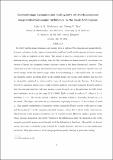Inertial-range dynamics and scaling laws of two-dimensional magnetic turbulence in the weak-field regime
Abstract
We study inertial-range dynamics and scaling laws in unforced two-dimensional magnetohydrodynamic turbulence in the regime of moderately small and small initial magnetic-to-kinetic energy ratio $r_0$, with an emphasis on the latter. The regime of small $r_0$ corresponds to a relatively weak field and strong magnetic stretching, whereby the turbulence is characterized by an intense conversion of kinetic into magnetic energy (dynamo action in the three-dimensional context). This conversion is an inertial-range phenomenon and, upon becoming quasi-saturated, deposits the converted energy within the inertial range rather than transferring it to the small scales. As a result, the magnetic energy spectrum $E_\b(k)$ in the inertial range can become quite shallow and may not be adequately explained or understood in terms of conventional cascade theories. It is demonstrated by numerical simulations at high Reynolds numbers (and unity magnetic Prandtl number) that the energetics and inertial-range scaling depend strongly on $r_0$. In particular, for fully developed turbulence with $r_0$ in the range $[1/4,1/4096]$, $E_\b(k)$ is found to scale as $k^{\alpha}$, where $\alpha\gtrsim-1$, including $\alpha>0$. The extent of such a shallow spectrum is limited, becoming broader as $r_0$ is decreased. The slope $\alpha$ increases as $r_0$ is decreased, appearing to tend to $+1$ in the limit of small $r_0$. This implies equipartition of magnetic energy among the Fourier modes of the inertial range and the scaling $k^{-1}$ of the magnetic potential variance, whose flux is direct rather than inverse. This behavior of the potential resembles that of a passive scalar. However, unlike a passive scalar whose variance dissipation rate slowly vanishes in the diffusionless limit, the dissipation rate of the magnetic potential variance scales linearly with the diffusivity in that limit. Meanwhile, the kinetic energy spectrum is relatively steep, followed by a much shallower tail due to strong anti-dynamo excitation. This gives rise to a total energy spectrum poorly obeying a power-law scaling.
Citation
Blackbourn , L A K & Tran , C V 2014 , ' Inertial-range dynamics and scaling laws of two-dimensional magnetic turbulence in the weak-field regime ' , Physical Review. E, Statistical, nonlinear, and soft matter physics , vol. 90 , 023012 . https://doi.org/10.1103/PhysRevE.90.023012
Publication
Physical Review. E, Statistical, nonlinear, and soft matter physics
Status
Peer reviewed
ISSN
1539-3755Type
Journal article
Description
The work reported here was partially supported by an EPSRC postgraduate studentship to L.A.K.B. L.A.K.B. was further supported by an EPSRC doctoral prize.Collections
Items in the St Andrews Research Repository are protected by copyright, with all rights reserved, unless otherwise indicated.

